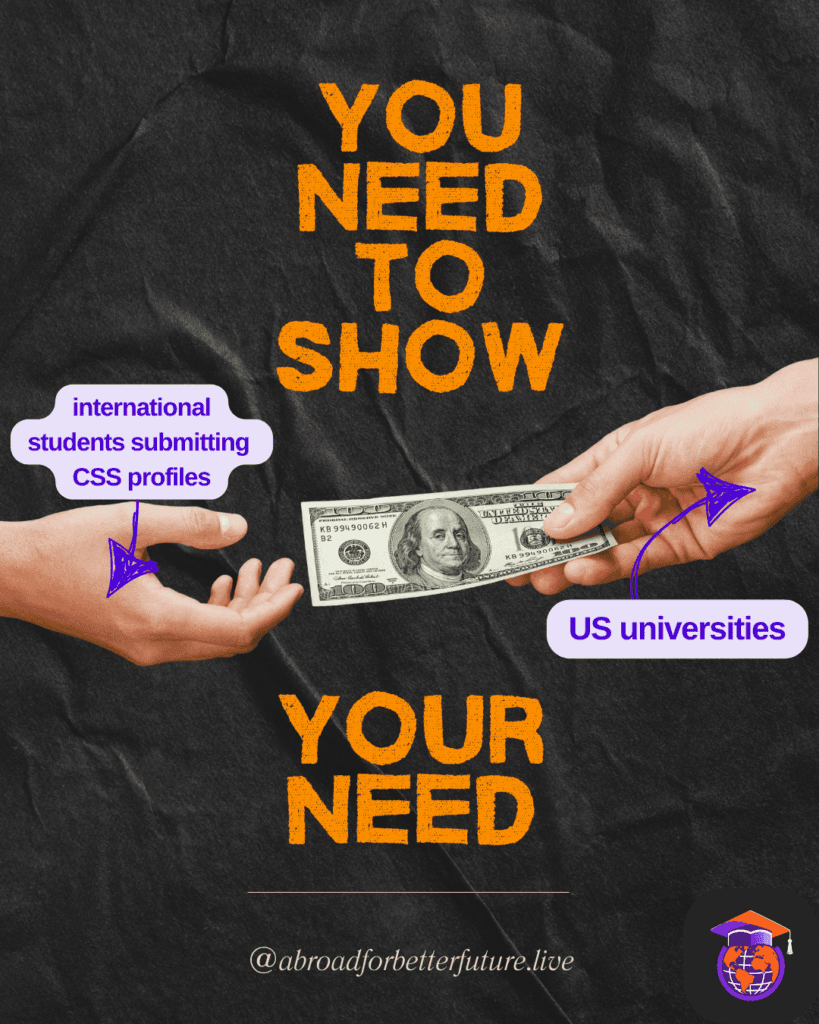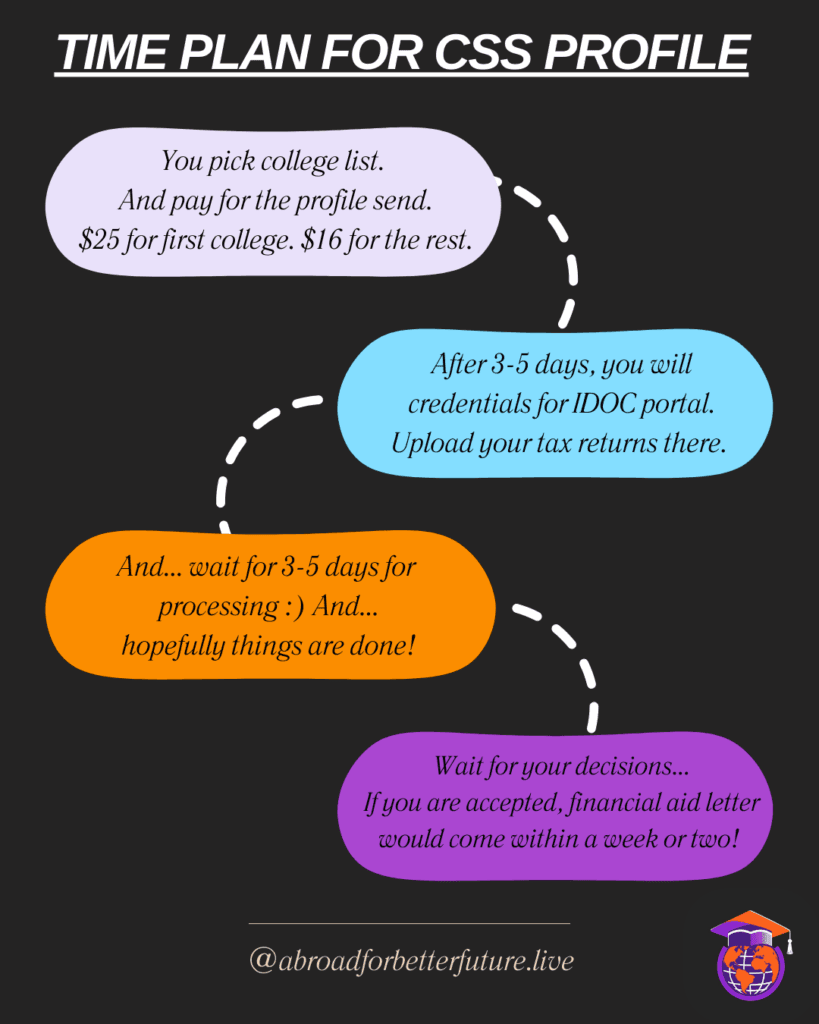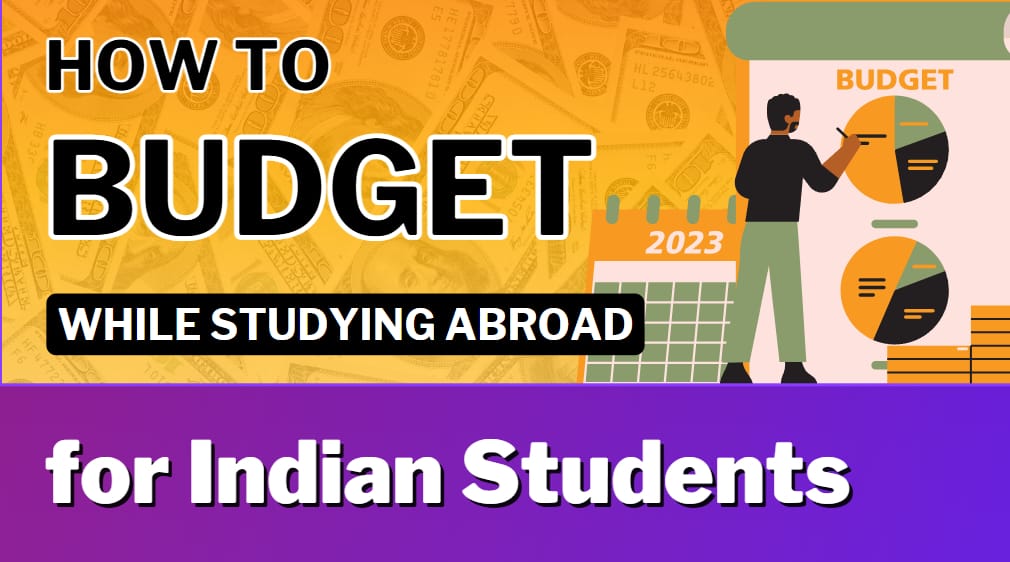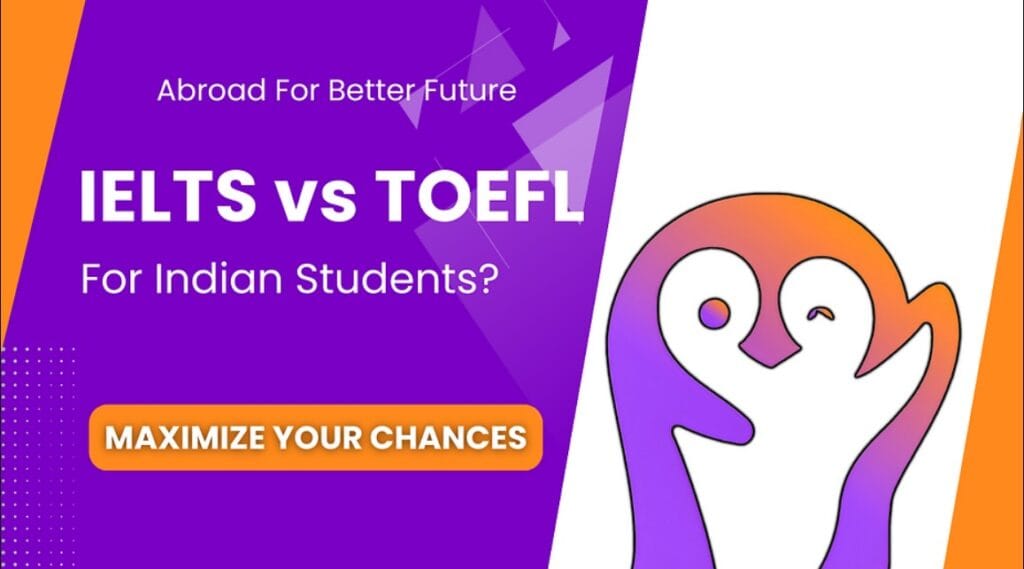Table of Contents of this Study Abroad Blog
Still Have Questions?
Navigating financial aid is tough, but you’re not alone.
Join our student community and get real answers from those who’ve done it before.

Why You Actually Need the CSS Profile (Even If You Don’t Want To)
Alright, let’s be real. If you’re an international student aiming for a U.S. university and hoping to get financial aid, you can’t ignore the CSS Profile. Unlike FAFSA (which is for U.S. citizens and green card holders), the CSS Profile is your only shot at need-based scholarships from private colleges.
And let’s get one thing straight—American universities are not just handing out money for fun.
If you don’t prove you need aid, you’re not getting it. Simple as that.
Btw I have already made a youtube video which is going quite good so I thought let’s make a tutorial kinda blog for like a CSS profile guide!
What is the CSS Profile & Why Do Indian Students Need It?
The CSS Profile (College Scholarship Service Profile) is an online financial aid form used by many U.S. universities to determine how much money you and your family can actually afford to pay. If you’re serious about studying in the U.S. but don’t have a fortune lying around, you need to fill this out.
If you mess up or try to fudge numbers on your CSS Profile, schools will find out. They have ways to verify your information, and if anything looks fishy, you can kiss that scholarship goodbye. Be clear about your family’s income, assets, and expenses. It might be tedious, but getting it right can literally save you thousands of dollars in tuition fees.
In short—if you want financial aid as an international student, you have no choice but to fill out the CSS Profile. Get it done properly, and you might just make your dream of studying in the U.S. a reality. Stay tuned for the next part, where we break down how to actually fill out the CSS Profile step-by-step.

CSS Profile vs. FAFSA: Key Differences International Students Should Know
When it comes to financial aid, FAFSA and CSS Profile serve different groups of students. FAFSA is strictly for U.S. citizens and permanent residents, while the CSS Profile is used by international students to apply for need-based aid at private U.S. universities.
You can’t be filling for FAFSA if you are an international student that’s the main thing.
But here’s some more differences…
Who Qualifies for Each?
- FAFSA: Only U.S. citizens, green card holders, and some eligible non-citizens.
CSS Profile: Available for both U.S. and international students applying for financial aid at participating institutions.
How FAFSA & CSS Profile Differ
- Who Runs It?
- FAFSA: U.S. federal government
- CSS Profile: College Board (same organization that handles SATs and AP exams)
- Cost
- FAFSA: Completely free
- CSS Profile: Costs $25 for the first school, $16 per additional school (though some students may qualify for fee waivers)
- Financial Details Required
- FAFSA: Focuses mainly on income
- CSS Profile: Asks for a more detailed financial breakdown—including home equity, non-custodial parent income, medical expenses, and student assets
- Methodology Used
- FAFSA: Uses Federal Methodology, which primarily considers gross parental income
- CSS Profile: Uses Institutional Methodology, which takes a broader view of financial circumstances, including factors like home value and special circumstances
- How Aid is Decided
- FAFSA: Aid is determined through a strict formula
- CSS Profile: Universities have more flexibility in how they assess financial need
- Who Accepts It?
- FAFSA: Used by all U.S. colleges that offer federal aid
- CSS Profile: Used mainly by private universities to distribute institutional financial aid
- Required Documents
- FAFSA: Tax returns & income information
- CSS Profile: More comprehensive, including bank statements, property values, and family expenses
Feature | FAFSA | CSS Profile |
Who Runs It? | U.S. Federal Government | College Board |
Who Can Use It? | U.S. citizens & green card holders | International & U.S. students |
Cost | Free | $25 for first school, $16 per extra school |
Financial Details | Basic income info | In-depth financial assessment |
Aid Determination | Fixed federal formula | College discretion |
Schools That Use It | All U.S. colleges with federal aid | Mostly private universities |
Required Documents | Tax returns & W-2s | Tax returns, bank statements, asset details |
How is CSS Profile Different from ISFAA?
Many universities also accept the ISFAA (International Student Financial Aid Application) instead of the CSS Profile. Unlike the CSS Profile, ISFAA is free but must be submitted directly to each university rather than through the College Board.
Here are the expenses you need to report to ISFAA:
- Utilities, Food, Clothing, Household Necessities
- Medical Expenses, Educational Expenses, Loan Payments
- Taxes, Savings/Retirement, Car Maintenance, Insurance
- Entertainment, Vacations, Servants, Transportation

Unlike the CSS Profile, ISFAA doesn’t have an online submission portal—you typically have to email it along with supporting documents.
Btw, here’s a list of universities that offer ISFAA. I made this 🙂
And this is how an ISFAA form looks. The logo of the college is placed on the top left.
Step-by-Step Guide to Completing the CSS Profile for Indian Students
Step 1: Creating a College Board Account & Selecting Schools
Before you begin, create a College Board account (or log in if you already have one). Once in, select the colleges you’re applying to—this will determine where your financial data gets sent.
Step 2: Gather Your Documents
Make sure you have:
- Tax returns (last 2 years)
- Bank statements
- Salary slips
- Details of investments (FDs, mutual funds, property values)
Step 3: Filling Out the CSS Profile Sections
You’ll have to enter detailed information about your family’s financial situation, including:
- Household income & expenses
- Parental employment details
- Student savings & investments
- Any financial aid/scholarships received previously
Step 4: Selecting Colleges & Submitting
Once you’ve completed the form, choose the colleges where you want to send your profile. Make sure to double-check the deadlines for each school!
Step 5: Pay the Fees & Submit
- The first CSS Profile submission costs $25
- Additional schools cost $16 each
Fee waivers may be available for low-income students
What Happens After Submission?
- Track Progress – After submitting, log into your College Board account to monitor your application status.
- IDOC Portal Access – Within a few days, you’ll get IDOC portal login details—this is where you upload income proof and other supporting documents.
- Document Uploading – Ensure your file names are correct before uploading! Incorrect filenames can delay processing.
Processing Time – It takes about 5 days for your documents to be reviewed.

Submitting ISFAA or ISAFA?
If you’re submitting ISFAA or ISAFA instead of the CSS Profile, you must email your documents directly to the admissions office. Some universities (like Bowdoin) have their own financial aid submission portals—check each school’s website for details.
Common Mistakes Indian Students Make When Filing the CSS Profile (And How to Avoid Them!)
Filing the CSS Profile is tricky, and many students make costly mistakes that can reduce their chances of getting aid. Here’s what you need to watch out for:

1. Not Filing Taxes or Providing Tax Documents
Even if your family’s income is minimal, universities often require proof of earnings. Neglecting to submit tax returns or non-filer statements can lead to delays or denial of aid.
Action Step: Ensure you provide the necessary financial documents as per each university’s requirements.
2. Incorrect Currency Reporting
The CSS Profile allows you to report finances in your home currency.
Entering amounts in U.S. dollars or using inconsistent exchange rates can cause inaccuracies.
Best Practice: Input all financial information in Indian Rupees (INR); the system will handle the conversion.
3. Leaving Sections Blank Instead of Entering “0”
Omitting responses can be interpreted as oversight.
Tip: If a question doesn’t apply, enter “0” rather than leaving it blank to indicate intentional non-applicability. Unless you actually have nothing in a category then, 0 is ok…
For example, when I was filling up the CSS profile, my family had no business income.
Because we don’t have any business. 😺
4. Underreporting Assets
Transparency is crucial.
Failing to disclose assets like property or investments can jeopardize your application.
Advice: Accurately report all assets to maintain credibility with financial aid offices.
5. Missing Priority Deadlines
Financial aid is often distributed on a first-come, first-served basis.
Late submissions may result in reduced aid opportunities.
Strategy: Mark all relevant deadlines and submit your CSS Profile promptly.
6. Overlooking Supplemental Documents
Additional documentation can provide context to your financial situation.
Action: Attach any required or relevant documents, such as explanations of unique financial circumstances, to strengthen your application.
In case you are looking for really amazing scholarships… click here and you will be redirected to our category page with major scholarship-related blogs.
Which US Universities Require the CSS Profile for International Students?
Many top-tier private colleges require the CSS Profile for international students applying for financial aid. These include:
- Ivy League schools (Harvard, Yale, Princeton, etc.)
- Top private universities (Stanford, Duke, NYU, etc.)
- Select public universities (UNC-Chapel Hill, UVA, etc.)
To find the full updated list, check the College Board’s official site or visit each university’s financial aid webpage.
Pro Tips to Increase Your Chances of Getting Financial Aid
1. Apply Early for Priority Consideration
Most aid is distributed on a first-come, first-served basis.
Submitting before the priority deadline gives you a better shot at receiving grants.
Submit ahead and please make sure that you are not MISSING the deadlines…
2. Write a Strong Financial Aid Appeal if Needed
Didn’t get enough aid? Many universities allow you to submit an appeal explaining any financial hardships (unexpected medical expenses, job loss, etc.). A well-written appeal can make a big difference.
And listen… you can always go for ISFAA or ISAFA or CSS… and linked is the DETAILED video on if they are the same or not… you will be shocked to see the video!
3. Check for Additional University-Specific Scholarships
Some schools offer extra merit-based aid for international students. Always research and apply for these scholarships separately.
4. Avoid Red Flags That Could Delay Your Aid
- Mismatched information (like different income figures across documents)
- Missing signatures on required forms
- Not providing explanations for unusual expenses
Stay organized, double-check everything, and submit early—these steps maximize your chances of getting the aid you need!

In the end, how to have a STRONG CSS PROFILE?
Filing the CSS Profile can be stressful, but it’s completely doable if you plan ahead. The key is accuracy, transparency, and meeting deadlines. Universities won’t hand out money unless you prove your financial need. Missing documents or incorrect information could cost you thousands in aid.
Here’s how you get it right:
- File your taxes or submit a Non-Filer Statement—colleges expect documentation.
- Enter financial details in INR—the system handles the conversion.
- Don’t leave sections blank—use “0” where necessary.
- Meet priority deadlines—early applicants get better chances.
- Explain special circumstances—attach supporting documents for clarity.
If you’re feeling lost, don’t do it alone. Join our community.
Frequently Asked Questions (FAQs) on the CSS Profile for Indian Students
Is the CSS Profile mandatory for all international students?
No. Not all universities require it. Some colleges use the ISFAA instead, while others don’t need financial forms unless you request aid. Always check the financial aid section of your target universities.
What if my family doesn’t file income tax returns in India?
That’s fine. You’ll need to estimate income using bank transactions and provide a Non-Filer Statement in the IDOC portal. Some colleges may ask for alternative proof, like salary slips or a letter explaining your financial situation.
Can I edit my CSS Profile after submitting it?
No. Once submitted, you can’t change it. If you made a critical mistake, contact the college’s financial aid office and ask if they’ll allow a correction or accept an additional document.
Do I need to submit a new CSS Profile every year?
Yes. If you’re applying for financial aid, most universities require a new CSS Profile annually to reassess your financial need. Keep track of deadlines and any changes in your family’s income.
How do I get a CSS Profile fee waiver as an Indian student?
Fee waivers for international students are rare. However, some universities—like Swarthmore—don’t need your CSS Profile unless you’re admitted. Check individual university policies for possible waivers.
Can I complete the CSS Profile in INR?
Yes! The CSS Profile requires you to enter all financial details in your home currency. The system will convert it automatically using the latest exchange rates.
What if my parents earn in different currencies?
Mention this in the Special Circumstances section. Provide details on income sources and conversion rates. This helps colleges better understand your financial situation.
How do I check the submission status of my CSS Profile?
Once you submit and pay, you’ll get a confirmation. Colleges may also update your applicant portal to show they received it. If you don’t see it listed, follow up with their financial aid office.
What if my parents are divorced or separated?
You may need both parents’ financial details. Some universities require a Non-Custodial Parent Profile. If you have no contact with one parent, you can request a waiver from the college.
What do I submit to IDOC if my parents don’t file U.S. tax returns?
You’ll need a Non-Filer Statement along with supporting documents, like bank statements, employer letters, or other proof of income. Colleges use these to assess your need for aid.
What is the deadline for submitting the CSS Profile?
Deadlines vary by college. Typically, it’s November 1 for Early Decision 1, January 15 for Early Decision 2, and February 1-15 for Regular Decision. Always check each college’s official deadline.
If you’re looking for practical guidance on self-funding, scholarships, or planning your study-abroad dream, join the AFBF community—India’s largest and most supportive study-abroad community. It’s free to join guys. We’re here to help you every step of the way!
Get your personalized study plan today!
Book Free Session






